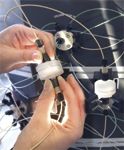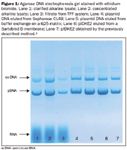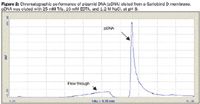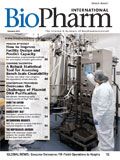The Purification of Plasmid DNA for Clinical Trials Using Membrane Chromatography
Membrane chromatography ensures purity at high flow rates.
ABSTRACT
Membrane chromatography offers a good solution to the challenge of developing an efficient chromatographic procedure for plasmid DNA purification. The large convective pores of anion exchange membranes allow plasmid DNA to access all the anionic binding sites of the membrane at high flow rates. Here we demonstrate that the pIDKE2 plasmid can be purified from a recombinant Escherichia coli lysate using a Sartobind D membrane combined with size exclusion chromatography to render material with 95% purity and an average yield of 50%. This process yields therapeutically suitable plasmid DNA that meets all regulatory requirements.
Gene therapy and DNA immunization are important and promising possibilities to successfully develop preventive and therapeutic strategies for various diseases. Thousands of people have already received plasmid DNA (pDNA) without serious adverse effects. In the last decade, an increasing number of clinical trials for gene therapies and vaccines based on pDNA have reached the final phases. However, the amount of highly purified pDNA that will be required for these products, should they ultimately reach the market, has been largely underestimated. Commercial-scale processes for plasmid production must be able to manufacture grams or even several kilograms of purified pDNA per batch while meeting the quality standards required by the health authorities.

(SARTORIUS AG)
The chromatographic supports used in purifying such plasmids play a major role these processes, the development of which can be challenging.1 In particular, RNA removal is a challenge because its chemical composition and structure are so similar to those of pDNA, and because it is so abundant in crude plasmid preparations.2–4 Also, the large pDNA molecules adsorb only on the outer surface of the particulate supports, and consequently their capacity is very low—usually on the order of only hundreds of micrograms of plasmid per milliliter of chromatographic support.5
Here we describe a procedure for purifying the pIDKE2 plasmid, which encodes the hepatitis C virus (HCV) core, E1, and E2 structural proteins, using a Sartobind D membrane (Sartorius-Stedim Biotech, Goettingen, Germany) at high flow rates. The quality of the pDNA produced using this membrane-based purification process was demonstrated using the analytical methods recommended in relevant US FDA guidance.6 The procedure delivers the pIDKE2 plasmid with an average yield of 50% and with 95% purity. The biological activity of the purified plasmid was confirmed in vivo: vaccinated mice developed a positive antibody response against all HCV structural antigens—86.6% and 60% for the core and E2 proteins, respectively.
MATERIALS AND METHODS
Materials
All the reagents used to make the buffers were purchased from Merck (Darmstadt, Germany) and Sigma (St. Louis, MO). G25 coarse chromatography medium, Sepharose CL-4B, and Sephacryl S-1000 were purchased from Amersham BioSciences (GE Healthcare, Piscataway, NJ).
Recombinant proteins
Recombinant Co.1207 and E1.3408 were obtained from E. coli. Co.120 comprises the first 120 amino acids (aa) of the HCV nucleocapsid protein, whereas E1.340 encompasses aa 192–340 of the viral protein.9 E2.680 comprises aa 384–680 of the HCV polyprotein and is obtained from recombinant Pichia pastoris.
Production of pIDKE2
E. coli DH10B cells harboring pIDKE2, a plasmid for DNA immunization expressing the first 650 aa of the HCV polyprotein from the 1b-Cuban isolate genotype,10 were grown overnight, at 37 °C, in 100 mL shake flasks containing 50 μg kanamycin/mL, at 250 rpm. The engineered E. coli was cultured in a 5-L fermenter (Marubishi, Tokyo, Japan) using a complex media containing 50 g/L of yeast extract in fed-batch mode.
Bacterial lysis and plasmid recovery
The bacterial cell paste (typically 200 g) was re-suspended in 2.4 L of a buffer containing 61 mM glucose, 10 mM Tris–HCL, and 50 mM EDTA, at pH 8. Bacteria were lysed using a previously described procedure.4 The clarified lysate was concentrated five times on a tangential flow filtration (TFF) system (nominal molecular weight cutoff 100,000 kDa, 0.1 m2 ). All experiments were conducted keeping a constant transmembrane pressure (TMP) of 0.8 bar at 4 °C, using Sartocon Slice equipment (Sartorius-Stedim Biotech). To remove RNA, the concentrated clarified lysate was loaded on Sepharose CL 4B in a BPG 113 column equilibrated with 20 mM Tris–HCL, 3 mM EDTA, and 1.5 M (NH4)2 SO4, at pH 7.2.
Plasmid capture and elution using the Sartobind membrane was carried out after buffer exchange on a G25 matrix using 25 mM Tris, 10 mM EDTA, and 0.5 M NaCl, at pH 8 and a rate of 50 mL/min, to reach a conductivity of 45 ms/cm. The pDNA fraction was pumped at 150 mL/min to the membrane holder 91-D-01K-15-03. After loading the feeding solution, the membrane was rinsed with a pH 8 buffer containing 25 mM Tris, 10 mM EDTA, and 0.7 M NaCl. Bound plasmid DNA was eluted with a buffer solution containing 25 mM Tris, 10 mM EDTA, and 1.2 M NaCl at pH 8. Finally, the membrane was regenerated using 0.5 M NaOH. The pDNA polishing was achieved on Sephacryl S-1000 media on a formulation buffer of 20 mM NaH2PO4–Na2HPO4, 1 mM EDTA, and 30 mM NaCl at pH 6.7, using a 50X K column (Amersham BioSciences) at 4.8 mL/min. Fractions containing more than 89% supercoiled pDNA were processed by TFF until reaching a concentration of 2 mg/mL as determined by the absorbance at 260, using a VivaFlow 200 system (nominal molecular weight cutoff 100,000 kDa, 200 cm2 ). The final pDNA was filtered (0.22 μm) before further analyses were performed.
Analytical Methods
Flow-through and eluted fractions were precipitated by adding one volume of 2-propanol for 15 min on ice and then centrifuged at 14,000g for 10 min at 4 °C. The pellet was washed with 70% ethanol and centrifuged again at 4,000g for 10 min. The pellet was air-dried for 5–10 min and dissolved in 50 μl 10 mM Tris–HCl at pH 8.5. Fractions prepared as described were tested for restriction digestion analysis, using transformation experiments, and analyzed by electrophoresis on 0.8% agarose gels. Binding capacity and pDNA purity were determined by measuring absorbance at 260 (A260) and 280 (A280) and expressed as the ratio A260/A280 in a low-salt buffer. The pDNA purified as reported was used as a positive control.4 Identity was evaluated by restriction endonuclease digestion using a panel of enzymes followed by analysis on agarose gels.
Mice immunization and biological activity
Fifteen female Balb/c mice (6 to 8 weeks old), purchased from CENPALAB (Havana, Cuba), were immunized intramuscularly three times every second week with 50 μg pIDKE2 + 5 μg Co.120, obtained using a method previously reported,4 or following the method described in the present paper. The presence of antibodies against recombinant HCV structural antigens were determined by ELISA, as previously described.11 The induction of antibody titers of above 1:50 against HCV structural antigens in >25% of the mice on day 42 was considered a positive response.
RESULTS AND DISCUSSION
Lysis and plasmid recovery
The most common method for isolating pDNA is based on alkaline treatment and detergent-mediated solubilization of the bacterial cell membranes. In the second stage, the pH of the solution is adjusted to a value close to 5.5 by adding potassium acetate.12 The change in the physicochemical conditions of the solution causes the renaturation and flocculation of the chDNA as well as the precipitation of protein–SDS complexes and cell wall debris.12 The insoluble material can then be separated from the liquor containing the pDNA by filtration or centrifugation; once separated, the liquor containing pDNA is subjected to downstream processing to recover and purify the product.2,13,14 In our process, the insoluble material is separated from the liquor containing the pIDKE2 plasmid by centrifugation. Loading the crude lysate containing large amounts of impurities such as chDNA, RNA, proteins, and endotoxins directly to a chromatography matrix is not recommended; primary purification is essential.13 The clarified lysate containing the plasmid is concentrated five times using a TFF system; however, this step is not sufficient to remove all the RNA (Figure 1, lane 2). RNase is commonly added to degrade the RNA but this procedure is not recommended by regulatory agencies; consequently the RNA content in the clarified lysate is very high—about 25 times the amount of the pDNA in weight.3 In the present process, 100% of the remaining RNA is removed from the concentrated cell lysate during the first chromatographic step on Sepharose CL-4B, with 91% of the pDNA recovered.4 The analysis on the agarose gel shows that pDNA eluted in the void volume can be efficiently separated from RNA (Figure 1, lane 4).

Figure 1
pIDKE2 purification on a Sartobind D membrane
Large biomolecules such as pDNA bind only to the surface of traditional chromatography beads; hence, the capacity for pDNA is much lower than it is for small biomolecules which are able to access the full volume of the beads.15

Figure 2
Figure 2 shows the chromatographic profile for the separation of pIDKE2 under the selected conditions. During loading, no significant amount of pDNA was detected in the flow-through at the high flow rate of 150 mL/min. We calculated the average dynamic binding capacity for 10 batches at 3.3 ± 0.8 mg pDNA per mL. This means that the capture of pDNA from E. coli lysate is more efficient and rapid using the Sartobind D membrane, which has a dynamic binding capacity between 4.1 and 2.5 mg pDNA per mL support using a flow rate of 4.3 column volumes per minute. This is a more desirable result than what can be achieved by conventional anion-exchange resins, which bind about 1 mg of pDNA per mL of resin at flow rates that typically are lower than 0.5 column volume per minute.16 Seventy percent of the pDNA was eluted with 90% purity as determined by agarose gel, and no RNA is found (Figure 1 lane 6, Table 1). In addition, the assays for proteins and endotoxins indicate that there was a reduction of these contaminants.

Table 1: Testing results of released purified pIDKE2 compared to specification limits.
The loading, washing, elution, and membrane regeneration procedures took place in 1.5 h. Thus, this approach significantly reduced the separation time and increased the throughput and productivity for pDNA recovery. The Sartobind D membrane was repeatedly used for 10 batches. After each run, the membrane was regenerated with 0.5 M sodium hydroxide, because of its high stability in alkaline solutions. During the process, no change in backpressure was observed, demonstrating the stability and reproducibility of the membrane.17
The final purification step was similar to that reported previously4: pDNA fractions were pooled, concentrated to 2 mg/mL by tangential flow filtration, and finally filtered (0.22 μm). The purification steps render a final high purity pIDKE2 plasmid with an average yield of 50%. The yield is influenced also by the homogeneity of pDNA in the cells. A summary of the analytical specifications according to FDA criteria is shown in Table 2. The purified plasmid pIDKE2 had 95% purity.

Table 2: Plasmid recovery, yield, protein, and endotoxin reduction for the Sartobind D capture step.
Plasmid identity was confirmed by restriction enzyme digestion and its activity confirmed by an in vivo assay. The purified pIDKE2 plasmid induced a positive response against HCV core and enveloped proteins, with 87% seroconversion against Co.120 and 60% against E2.680 proteins, respectively.
CONCLUSIONS
Our process produces plasmid DNA (pDNA) with 95% purity, and the process fulfills all regulatory requirements and renders pharmaceutical-grade pDNA The content of genomic DNA is lower than 5 ng per dose, RNA is not detectable by agarose gel electrophoresis; endotoxin content is 0.77 EU per kg body weight, and the protein content is 4.1 μg per dose, which is lower than the limit established.
In conclusion, this process, which combines size exclusion and membrane chromatography, met the criteria of purity, robustness, and reproducibility required for manufacturing pharmaceutical-grade pDNA for human clinical trials.
Miladys Limonta is a principal researcher and Gabriel Márquez is the department head, both in downstream process development, Martha Pupo is a specialist in analytical development, and Odalys Ruíz is a researcher in fermentation development, all at the Centre for Genetic Engineering and Biotechnology, Havana, Cuba, miladys.limonta@cigb.edu.cu +(53-7) 271-6013.
REFERENCES
1. Urthaler J, Schleg R, Pogdornik A, Strancar A, Jungbauer A, Necina R. Application of Monoliths for plasmid DNA purification development and transfer to production. J Chrom A. 2005;1065: 93–106.
2. Ayazy P. Scaleable processes for the manufacture of therapeutic quantities of plasmid DNA. Biotech Appl Biochem. 2003;37:207–18.
3. Stadler J, Lemmens R, Nyhammar T. Plasmid DNA purification. J Gene Med. 2004;6:S54–S66.
4. Limonta M, Márquez G, Rey I, Pupo M, Ruíz O, Amador-Cañizare Y. Plasmid DNA recovery using size exclusion and perfusion chromatography. BioPharm Int. 2008;21:38–48.
5. Lemmens R, Olsson U, Nyhammar T, Stadler J. Supercoiled plasmid DNA: selective purification by thiophilic/aromatic adsorption. J Chromatogr B. 2003;784:291–300.
6. US Food and Drug Administration. Guidance for Industry: Considerations for Plasmid DNA vaccines for Infectious Disease Indications. Rockville, MD: 2005 Feb.
7. Dueñas-Carrera S, Morales J, Acosta-Rivero N, Lorenzo LJ, García C, Ramos T. Variable level expression of hepatitis C virus core protein in a prokaryotic system. Analysis of the humoral response in rabbit. Biotecnología Aplicada. 1999;16: 226–31.
8. Lorenzo LJ, Garcia O, Acosta-Rivero N, Dueñas-Carrera S, Martinez G, Alvarez-Obregon J. Expression and immunological evaluation of the Escherichia coli-derived hepatitis C virus envelope E1 protein. Biotechnol Appl Biochem. 2000;32:137–43.
9. Martínez-Donato G, Capdesuñer Y, Acosta-Rivero N, Rodríguez A, Morales-Grillo J, Martínez E. Multimeric HCV E2 protein obtained from Pichia pastoris cells induces a strong immune response in mice. Mol Biotechnol. 2007;35:225–35.
10. Dueñas-Carrera S, Alvarez-Lajonchere L, Alvarez-Obregón JC, Pérez A, Acosta-Rivero N, Vázquez DM. Enhancement of the immune response generated against hepatitis C virus enveloped proteins after DNA vaccination with polyprotein-encoding plasmids. Biotechnol Appl Biochem. 2002;35:205–12.
11. Acosta-Rivero N, Aguilera Y, Falcon V, Poutou J, Musacchio A, Alvarez-Lajonchere A. Ultrastructural and immunological characterization of hepatitis C core protein–DNA plasmid complexes. Am J Immunol. 2006;2:67–72.
12. Birnboim HC. A rapid alkaline extraction method for the isolation of plasmid DNA. Methods Enzymology. 1983;100:243–55.
13. Duval E, Burke G. Purification of pharmaceutical-grade plasmid DNA by anion-exchange chromatography in an RNase-free process. J Chromatogr B.2004;804:327–35.
14. Meacle FJ, Lander R, Ayazi Shamlou P, Titchener-Hooker NJ. Impact of Engineering Flow Conditions on Plasmid DNA Yield and Purity in Chemical Cell Lysis Operations. Biotechnol Bioeng. 2004;87:293–302.
15. Endres HN, Johnson JAC, Ross CA, Welp JK, Etzel MR. Evaluation of an ion-exchange membrane for the purification of plasmid DNA, Biotechnol Appl Biochem. 2003;37:259–66.
16. Zhang S, Krivosheyeva A, Nochumson S. Large scale capture and partial purification of plasmid DNA using anion-exchange membrane capsules. Biotechnol Appl Biochem. 2003;37:245–9.
17. Gottschalk U, Fischer-Fruehholz S, Reif O. Membrane adsorbers—A cutting edge process technology at the threshold. Bioprocess Int. 2004 May;(5):56–65.
